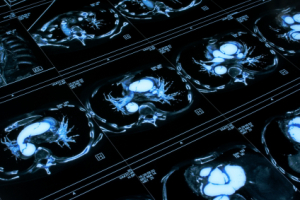by
Brendon Nafziger, DOTmed News Associate Editor | March 01, 2010

Bioelectrical information may
help CT interpretation
A Salt Lake City, Utah company is looking for international partners to market a new kind of lung scan they say in 15 minutes can help determine if a mass in the lung is malignant, thereby cutting down on unnecessary lung biopsies and surgeries.
The business, Freshmedx, hopes to drum up support for a scanner that measures bioelectrical conductance, or how much resistance tissue gives to a precision microcurrent of electricity.
Steven Eror, CEO of Freshmedx, tells DOTmed News that there's "abundant evidence" in the medical literature to show that malignant and benign growths resist the passage of current differently, and he notes similar technology has been used, and FDA-approved, for breast cancer detection.



Ad Statistics
Times Displayed: 2548
Times Visited: 12 Fast-moving cardiac structures have a big impact on imaging. Fujifilm’s SCENARIA View premium performance CT brings solutions to address motion in Coronary CTA while delivering unique dose saving and workflow increasing benefits.
"The peer-reviewed literature shows that when a microcurrent passes through tissue that's cancerous its resistance can be 15 to 50 times higher than adipose [fatty] or benign tissue," he says.
Freshmedx's device, about the size of an ultrasound machine, features a computer-controlled probe that measures bioconductance at specific chest locations. The tool, dubbed the Freshmedx Bioconductance Scan Platform, records tissue resistance, validates the measurement and then sends the results to a central server. The server generates a report, like a pathogen report from a blood test, showing how likely it is that the mass is malignant or benign.
The hope is that the device could be paired with CT scans to improve accurate detection of malignancy in a mass to prevent unneeded, and potentially dangerous, invasive procedures used to diagnose lung cancer.
"We are very focused: to bolster the findings of a CT and determine whether it's likely that the mass seen by the CT [is cancerous]," Eror says.
While CT scans are incredibly sensitive, meaning that they can pick up even tiny lumps, they often can't distinguish harmless growths from deadly cancers. For instance, according to the National Institutes of Health, studies show that more than 50 percent of CT scans of individuals symptomatic of lung cancer will detect abnormalities -- abnormalities that turn out to be non-cancerous when biopsied.
Eror says this is particularly true of a kind of growth known as a solitary pulmonary nodule. "These could be scar tissue from asthma or a benign mass from another origin," Eror says, but the CT scan often has no way of determining that.
To figure out what the abnormalities are, doctors typically order a bronchoscopic examination of the lung when the abnormality is located near an airway. Bronchoscopes are tubes threaded into the lung to examine tissue. If the mass is located elsewhere in the lung, lung surgery is used to biopsy the mass. These costly, open-chest operations require lengthy hospital stays and have a 5 percent mortality rate, according to Freshmedx.

